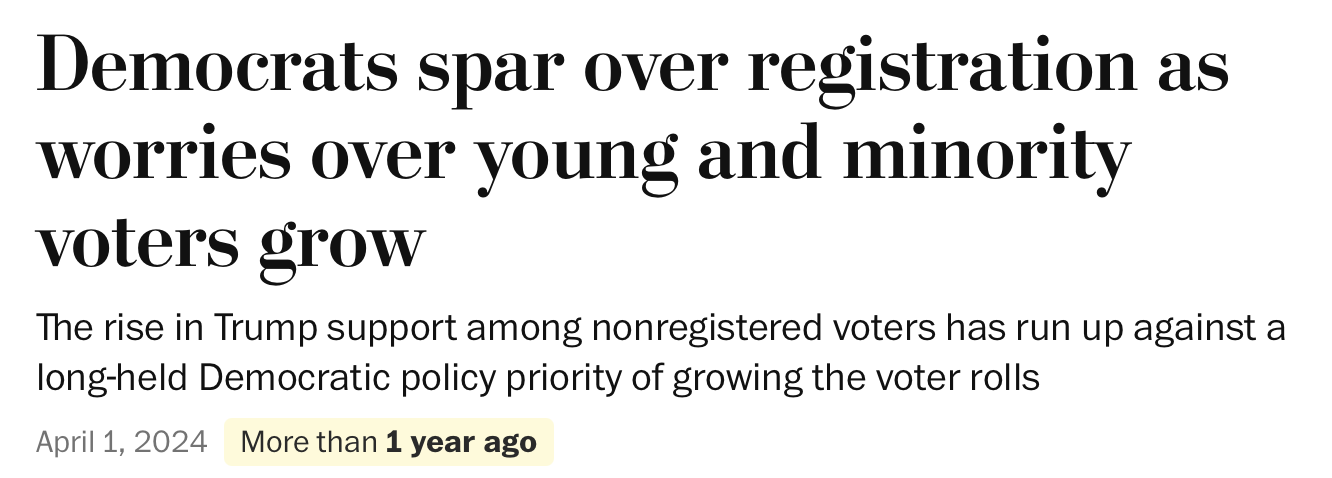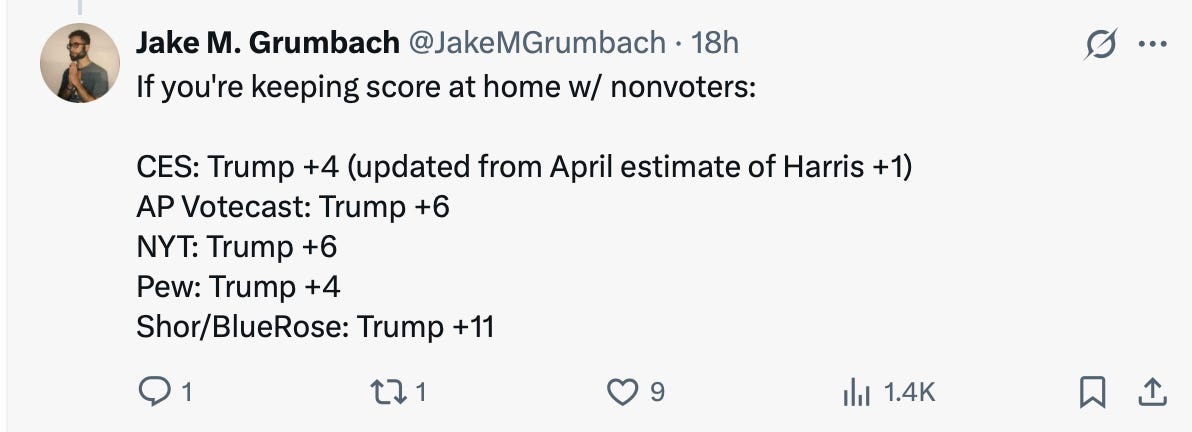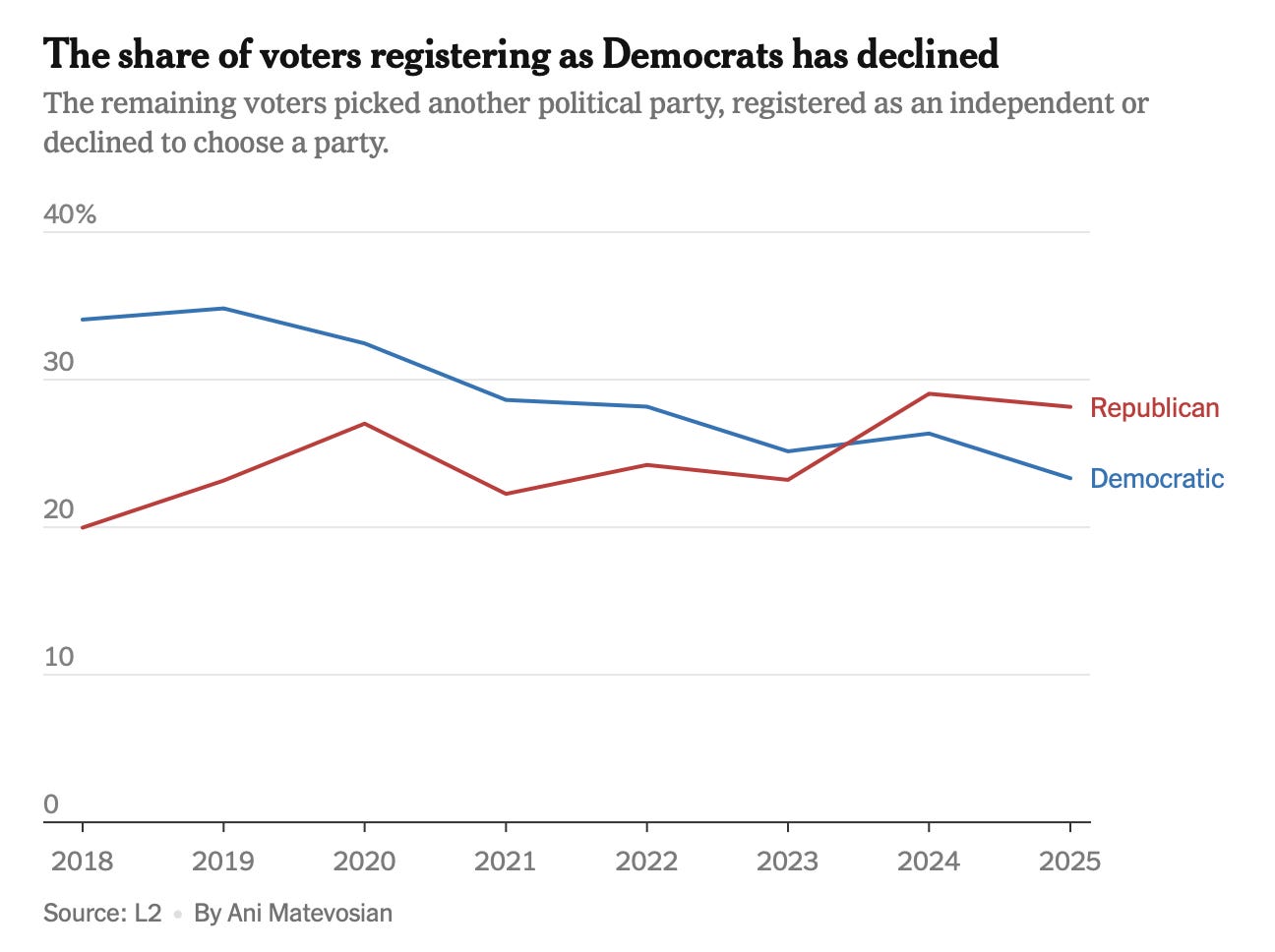901: Reality Finally Registers
Persuasion beats Hopium. New data on the path to beating MAGA.
This is the 100th edition of Groups Chat, our daily briefing for WelcomeStack partners focused on building what Democrats need to win majorities. The work is growing bigger, but the clock is ticking even louder: there are just 901 days until the first Democratic presidential primary.
Support the work: become a paid subscriber, or reply to this email to join in.
Two big new national analyses out this week show big challenges for Democrats and resolve major intra-party debates:
The Democratic Party Faces a Voter Registration Crisis: Shane Goldmacher, writing in The New York Times, has a comprehensive analysis of changes in party registration showing the newfound Republican advantage running across the board nationally.
Trump built support in 2024 by taking advantage of cracks in the Democratic Party’s coalition: Caroline Soler and Brian Schaffner in the Cooperative Election Study (CES) blog. CES is the largest academic survey focused on American elections conducted in collaboration with dozens of universities and partially funded by the National Science Foundation. With data from both before and after the election, CES shows that non-voters favored Trump. That is, if every voter voted, Trump would have done even better in 2024.
This is bad news.
This analysis also resolves long-running debates involving familiar players in the struggle over the future of the Democratic Party, largely centered over whether party actors should focus on persuading voters or just getting more people voting.
From last April:
Retractions and revisions have followed the recent articles.
In the Times: Tom Bonier, a frequent contributor to Simon Rosenberg’s misleading “Hopium” narrative that Biden (and later Harris) were on a good trajectory, flatly states, “I was wrong.”
Stanford & Berkeley professors Adam Bonica & Jake Grumbach are also revising their vociferous objection to the findings that Trump won non-voters.
From Last April:
From Yesterday: Grumbach’s update notes every single major analysis shows that non-voters leaned towards Trump in 2024.
What The Data Says on Registration
Back to the Times analysis, which contains many telling charts that should haunt Democrats. Like this one:
The story is straightforward, and damning:
The Democratic Party is hemorrhaging voters long before they even go to the polls.
Of the 30 states that track voter registration by political party, Democrats lost ground to Republicans in every single one between the 2020 and 2024 elections — and often by a lot.
That four-year swing toward the Republicans adds up to 4.5 million voters, a deep political hole that could take years for Democrats to climb out from.
…
That swing helps to explain President Trump’s success last year, when he won the popular vote for the first time, swept the swing states and roared back to the White House.
“I don’t want to say, ‘The death cycle of the Democratic Party,’ but there seems to be no end to this,” said Michael Pruser, who tracks voter registration closely as the director of data science for Decision Desk HQ, an election-analysis site. “There is no silver lining or cavalry coming across the hill. This is month after month, year after year.”
The shifts also previewed Democratic weaknesses in 2024. The party saw some of its steepest declines in registration among men and younger voters, the Times analysis found — two constituencies that swung sharply toward Mr. Trump.
Newly registered voters are a big problem. Over the past six years, “Republicans went from roughly one-third of newly registered voters under 45 to a majority.”
The overall change is not just newly registered voters, though:
Much of that change is from party switchers. From 2020 through July 2025, nearly twice as many Pennsylvania Democrats switched to become Republicans (314,000) as the other way around (161,000), state records show.
“Anyone who says that these things are not concerning for Democrats is, in my opinion, mostly lying,” said Lakshya Jain, a Democratic analyst and co-founder of Split Ticket, a nonpartisan election-analysis site. “The act of being a registered Democrat is still psychologically something. The act of switching is a political statement.”
No More Hopium or Nihilism
Why does it matter that Bonier, Rosenberg, Bonica, Grumbach, etc. were wrong?
Because several of them are still advocating for Democrats to avoid the difficult steps required to win. Here’s how we framed it in CNN before the June debate last year:
The biggest obstacle to President Joe Biden’s reelection is not that polls show sharp declines in support among important Democratic demographic groups from 2020 to today. It’s denying this reality … The phenomenon of Democrats dismissing the polls in favor of misplaced optimism has been termed “hopium” by data journalist Nate Silver. Its most prominent booster, Simon Rosenberg, has made this anti-polling case on CNN and in other major outlets. But it is not just Rosenberg who has injected this overly rosy perspective into the national narrative.
Bonica & Grumbach continue to pump out research denying that the depolarizing centrist Democrats winning Trump districts have a replicable approach. They have been critiqued as sharing “unfounded nihilism.” As we covered in The Undecided Nihilists, this attitude makes it much harder to build support for the candidates we know can win on MAGA turf.
We know they are wrong. They were wrong in 2024, and wrong again in early 2025. And they are still wrong now.
But winning the argument isn’t enough to win back the House in 2026, or put Democrats on the path to the White House in the primary starting 901 days from today.
We need to organize, not just debate. We need to support candidates who can win the middle, like the seven we’ve already endorsed for the midterms — all over-performers in Trump districts:
Winning is better than being right, and we’ve got to win more.







